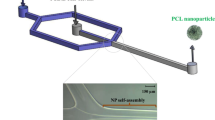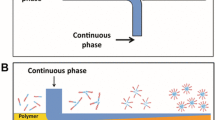Abstract
Micro and nanotechnology can potentially revolutionize drug delivery systems. Novel microfluidic systems have been employed for the cell culture applications and drug delivery by micro and nanocarriers. Cells in the microchannels are under static and dynamic flow perfusion of culture media that provides nutrition and removes waste from the cells. This exerts hydrostatic and hydrodynamic forces on the cells. These forces can considerably affect the functions of the living cells. In this paper, we simulated the flow of air, culture medium, and the particle transport and deposition in the microchannels under different angles of connection inlet. It was found that the shear stress induced by the medium culture flow is not so high to damage the cells and that it is roughly uniform in the cell culture section (CCS). However, the local shear stresses in the other parts of the microchip differ by changing the angles of the connection inlet. The results showed that the particle deposition was a function of the particle size, the properties of the fluid, and the flow rate. At a lower air flow rate, both small and large particles deposited in the entrance region and none of them reached the CCS. Once the airflow rate increased, the drag of the flow could overcome the diffusion of the small particles and deliver them to the CCS so that more than 88% of the 100 nm and 98% of the 200 nm particles deposited in the CCS. However, larger particles with average diameters in micrometers could not reach the CCS by the airflow even at high flow rate. In contrast, our findings indicated that both small and large particles could be delivered to the CCS by liquid flow. Our experimental data confirm that microparticles (with diameters of 5 and 20 μm) suspended in a liquid can reach the CCS at a well-adjusted flow rate. Consequently, a liquid carrier is suggested to transport large particles through microchannels. As a powerful tool, these numerical simulations provide a nearly complete understanding of the flow field and particle patterns in microchips which can significantly lower the trial and error in the experiment tests and accordingly save researchers considerable cost and time for drug delivery to the cell in the microchip by micro/nanocarriers.














Similar content being viewed by others
References
Nguyen N-T, Shaegh SAM, Kashaninejad N, Phan D-T. Design, fabrication and characterization of drug delivery systems based on lab-on-a-chip technology. Adv Drug Deliv Rev. 2013;65(11):1403–19. https://doi.org/10.1016/j.addr.2013.05.008.
Kashaninejad N, Nikmaneshi MR, Moghadas H, Kiyoumarsi Oskouei A, Rismanian M, Barisam M, et al. Organ-tumor-on-a-chip for chemosensitivity assay: a critical review. Micromachines. 2016;7(8):130. https://doi.org/10.3390/mi7080130.
Nguyen N-T, Hejazian M, Ooi CH, Kashaninejad N. Recent advances and future perspectives on microfluidic liquid handling. Micromachines. 2017;8(6):186. https://doi.org/10.3390/mi8060186.
Moghadas H, Saidi MS, Kashaninejad N, Kiyoumarsioskouei A, Nguyen N-T. Fabrication and characterization of low-cost, bead-free, durable and hydrophobic electrospun membrane for 3D cell culture. Biomed Microdevices. 2017;19(4):74. https://doi.org/10.1007/s10544-017-0215-y.
Levy R, Hill DB, Forest MG, Grotberg JB. Pulmonary fluid flow challenges for experimental and mathematical modeling. Integr Comp Biol. 2014;54(6):985–1000. https://doi.org/10.1093/icb/icu107.
Tavana H, Kuo C-H, Lee QY, Mosadegh B, Huh D, Christensen PJ, et al. Dynamics of liquid plugs of buffer and surfactant solutions in a micro-engineered pulmonary airway model. Langmuir. 2009;26(5):3744–52.
Douville NJ, Zamankhan P, Tung Y-C, Li R, Vaughan BL, Tai C-F, et al. Combination of fluid and solid mechanical stresses contribute to cell death and detachment in a microfluidic alveolar model. Lab Chip. 2011;11(4):609–19. https://doi.org/10.1039/C0LC00251H.
Huh D, Matthews BD, Mammoto A, Montoya-Zavala M, Hsin HY, Ingber DE. Reconstituting organ-level lung functions on a chip. Science. 2010;328(5986):1662–8. https://doi.org/10.1126/science.1188302.
Huh D, Leslie DC, Matthews BD, Fraser JP, Jurek S, Hamilton GA, et al. A human disease model of drug toxicity-induced pulmonary edema in a lung-on-a-chip microdevice. Sci Transl Med. 2012;4(159):159ra147.
Rothen-Rutishauser BM, Kiama SG, Gehr P. A three-dimensional cellular model of the human respiratory tract to study the interaction with particles. Am J Respir Cell Mol Biol. 2005;32(4):281–9. https://doi.org/10.1165/rcmb.2004-0187OC.
Howell M, Wang C, Mahmoud A, Hellermann G, Mohapatra S, Mohapatra S. Dual-function theranostic nanoparticles for drug delivery and medical imaging contrast: perspectives and challenges for use in lung diseases. Drug Deliv Transl Res. 2013;3(4):352–63. https://doi.org/10.1007/s13346-013-0132-4.
Hittinger M, Juntke J, Kletting S, Schneider-Daum N, de Souza Carvalho C, Lehr C-M. Preclinical safety and efficacy models for pulmonary drug delivery of antimicrobials with focus on in vitro models. Adv Drug Deliv Rev. 2015;85:44–56. https://doi.org/10.1016/j.addr.2014.10.011.
Moghadas H, Abouali O, Faramarzi A, Ahmadi G. Numerical investigation of septal deviation effect on deposition of nano/microparticles in human nasal passage. Respir Physiol Neurobiol. 2011;177(1):9–18. https://doi.org/10.1016/j.resp.2011.02.011.
Nagy A, Steinbrück A, Gao J, Doggett N, Hollingsworth JA, Iyer R. Comprehensive analysis of the effects of CdSe quantum dot size, surface charge, and functionalization on primary human lung cells. ACS Nano. 2012;6(6):4748–62. https://doi.org/10.1021/nn204886b.
Blank F, Rothen-Rutishauser BM, Schurch S, Gehr P. An optimized in vitro model of the respiratory tract wall to study particle cell interactions. J Aerosol Med. 2006;19(3):392–405. https://doi.org/10.1089/jam.2006.19.392.
Sera T, Uesugi K, Yagi N, Yokota H. Numerical simulation of airflow and microparticle deposition in a synchrotron micro-CT-based pulmonary acinus model. Comput Methods Biomech Biomed Eng. 2015;18(13):1427–35. https://doi.org/10.1080/10255842.2014.915030.
Pourmehran O, Rahimi-Gorji M, Gorji-Bandpy M, Gorji T. Simulation of magnetic drug targeting through tracheobronchial airways in the presence of an external non-uniform magnetic field using Lagrangian magnetic particle tracking. J Magn Magn Mater. 2015;393:380–93. https://doi.org/10.1016/j.jmmm.2015.05.086.
Bailey MM, Berkland CJ. Nanoparticle formulations in pulmonary drug delivery. Med Res Rev. 2009;29(1):196–212. https://doi.org/10.1002/med.20140.
Mishra DK, Dhote V, Bhatnagar P, Mishra PK. Engineering solid lipid nanoparticles for improved drug delivery: promises and challenges of translational research. Drug Deliv Transl Res. 2012;2(4):238–53. https://doi.org/10.1007/s13346-012-0088-9.
Nagel T, Resnick N, Dewey CF, Gimbrone MA. Vascular endothelial cells respond to spatial gradients in fluid shear stress by enhanced activation of transcription factors. Arterioscler Thromb Vasc Biol. 1999;19(8):1825–34. https://doi.org/10.1161/01.ATV.19.8.1825.
Legant WR, Miller JS, Blakely BL, Cohen DM, Genin GM, Chen CS. Measurement of mechanical tractions exerted by cells in three-dimensional matrices. Nat Methods. 2010;7(12):969–71. https://doi.org/10.1038/nmeth.1531.
Huang S, Chen CS, Ingber DE. Control of cyclin D1, p27Kip1, and cell cycle progression in human capillary endothelial cells by cell shape and cytoskeletal tension. Mol Biol Cell. 1998;9(11):3179–93. https://doi.org/10.1091/mbc.9.11.3179.
McBeath R, Pirone DM, Nelson CM, Bhadriraju K, Chen CS. Cell shape, cytoskeletal tension, and RhoA regulate stem cell lineage commitment. Dev Cell. 2004;6(4):483–95. https://doi.org/10.1016/S1534-5807(04)00075-9.
Wang H, Riha GM, Yan S, Li M, Chai H, Yang H, et al. Shear stress induces endothelial differentiation from a murine embryonic mesenchymal progenitor cell line. Arterioscler Thromb Vasc Biol. 2005;25(9):1817–23. https://doi.org/10.1161/01.ATV.0000175840.90510.a8.
Young EW, Wheeler AR, Simmons CA. Matrix-dependent adhesion of vascular and valvular endothelial cells in microfluidic channels. Lab Chip. 2007;7(12):1759–66. https://doi.org/10.1039/b712486d.
Shamloo A, Ma N, Poo M-M, Sohn LL, Heilshorn SC. Endothelial cell polarization and chemotaxis in a microfluidic device. Lab Chip. 2008;8(8):1292–9. https://doi.org/10.1039/b719788h.
Kim M-G, Kim Y-H, Kim H-L, Park CW, Joe Y-H, Hwang J, et al. Wall loss reduction technique using an electrodynamic disturbance for airborne particle processing chip applications. J Micromech Microeng. 2010;20(3):035034.
Sriphutkiat Y, Zhou Y. Particle accumulation in a microchannel and its reduction by a standing surface acoustic wave (SSAW). Sensors. 2017;17(1):106. https://doi.org/10.3390/s17010106.
Porter B, Zauel R, Stockman H, Guldberg R, Fyhrie D. 3-D computational modeling of media flow through scaffolds in a perfusion bioreactor. J Biomech. 2005;38(3):543–9. https://doi.org/10.1016/j.jbiomech.2004.04.011.
Singh H, Teoh S-H, Low HT, Hutmacher D. Flow modelling within a scaffold under the influence of uni-axial and bi-axial bioreactor rotation. J Biotechnol. 2005;119(2):181–96. https://doi.org/10.1016/j.jbiotec.2005.03.021.
Cioffi M, Boschetti F, Raimondi MT, Dubini G. Modeling evaluation of the fluid-dynamic microenvironment in tissue-engineered constructs: a micro-CT based model. Biotechnol Bioeng. 2006;93(3):500–10. https://doi.org/10.1002/bit.20740.
Boschetti F, Raimondi MT, Migliavacca F, Dubini G. Prediction of the micro-fluid dynamic environment imposed to three-dimensional engineered cell systems in bioreactors. J Biomech. 2006;39(3):418–25. https://doi.org/10.1016/j.jbiomech.2004.12.022.
Galbusera F, Cioffi M, Raimondi M, Pietrabissa R. Computational modeling of combined cell population dynamics and oxygen transport in engineered tissue subject to interstitial perfusion. Comput Methods Biomech Biomed Eng. 2007;10(4):279–87. https://doi.org/10.1080/10255840701318404.
Raimondi MT, Bridgen DT, Laganà M, Tonnarelli B, Cioffi M, Boschetti F, et al. Integration of experimental and computational microfluidics in 3D tissue engineering. Methods in bioengineering 3D tissue engineering. In: Yarmush ML, Langer RS, editors. Book series: methods in bioengineering (MIB). F. Berthiaume and. J Morgan ed. Boston: Artech House; 2010. p. 237–42.
Sellgren KL, Butala EJ, Gilmour BP, Randell SH, Grego S. A biomimetic multicellular model of the airways using primary human cells. Lab Chip. 2014;14(17):3349–58. https://doi.org/10.1039/C4LC00552J.
Huh D, Hamilton GA, Ingber DE. From 3D cell culture to organs-on-chips. Trends Cell Biol. 2011;21(12):745–54. https://doi.org/10.1016/j.tcb.2011.09.005.
Raimondi M, Boschetti F, Falcone L, Fiore G, Remuzzi A, Marinoni E, et al. Mechanobiology of engineered cartilage cultured under a quantified fluid-dynamic environment. Biomech Model Mechanobiol. 2002;1(1):69–82. https://doi.org/10.1007/s10237-002-0007-y.
Ferrell N, Desai RR, Fleischman AJ, Roy S, Humes HD, Fissell WH. A microfluidic bioreactor with integrated transepithelial electrical resistance (TEER) measurement electrodes for evaluation of renal epithelial cells. Biotechnol Bioeng. 2010;107(4):707–16. https://doi.org/10.1002/bit.22835.
Zhao B, Zhang Y, Li X, Yang X, Huang D. Comparison of indoor aerosol particle concentration and deposition in different ventilated rooms by numerical method. Build Environ. 2004;39(1):1–8. https://doi.org/10.1016/j.buildenv.2003.08.002.
Hinds, W.C., Aerosol technology: properties, behavior, and measurement of airborne particles. 2012: John Wiley & Sons.
Zhang H, Ahmadi G. Aerosol particle transport and deposition in vertical and horizontal turbulent duct flows. J Fluid Mech. 2000;406:55–80. https://doi.org/10.1017/S0022112099007284.
Herman, I.P., Physics of the human body. 2016: Springer.
Horsfield K. Morphometry of the small pulmonary arteries in man. Circ Res. 1978;42(5):593–7. https://doi.org/10.1161/01.RES.42.5.593.
Huh D, Kim HJ, Fraser JP, Shea DE, Khan M, Bahinski A, et al. Microfabrication of human organs-on-chips. Nat Protoc. 2013;8(11):2135–57. https://doi.org/10.1038/nprot.2013.137.
Sznitman J. Respiratory microflows in the pulmonary acinus. J Biomech. 2013;46(2):284–98. https://doi.org/10.1016/j.jbiomech.2012.10.028.
Leslie, D.C., Domansky, K., Hamilton, G.A., Bahinski, A., and Ingber, D.E., Aerosol drug delivery for lung on a chip, in 15th International Conference on Miniaturized Systems for Chemistry and Life Sciences. 2011: Washington, USA p 97–99.
Author information
Authors and Affiliations
Corresponding author
Ethics declarations
Conflicts of interest
The authors declare that they have no conflict of interest.
Rights and permissions
About this article
Cite this article
Moghadas, H., Saidi, M.S., Kashaninejad, N. et al. Challenge in particle delivery to cells in a microfluidic device. Drug Deliv. and Transl. Res. 8, 830–842 (2018). https://doi.org/10.1007/s13346-017-0467-3
Published:
Issue Date:
DOI: https://doi.org/10.1007/s13346-017-0467-3




